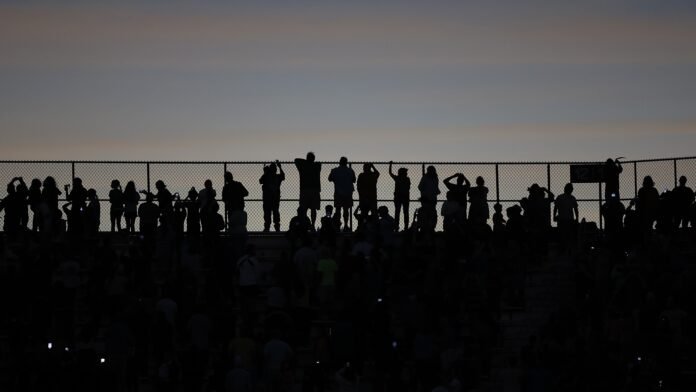Total Solar Eclipse 2027: Debunking the “World to Go Dark” Myth and Exploring the Eclipse of the Century
A viral claim has been circulating online and on social media, stating that the world will go dark for six minutes on August 2, and that this phenomenon won’t happen again for 100 years. However, this claim is false, and what’s actually happening is a rare and spectacular total solar eclipse on August 2, 2027, which is being dubbed the “eclipse of the century.” In this article, we’ll explore the facts behind this event, what to expect, and why it’s a must-see experience for space enthusiasts.
The total solar eclipse on August 2, 2027, is a highly anticipated event that will bring the longest totality on land of the entire 21st century, with the moon completely blocking the sun for up to 6 minutes and 22 seconds. This rare phenomenon will be visible in parts of 11 countries, mostly across North Africa and the Middle East, and will offer a unique experience for those in the path of totality. But before we dive into the details, let’s set the record straight: the world will not go dark on August 2, 2027, or any other day, as a global blackout is not possible.
What is a Total Solar Eclipse?
A total solar eclipse occurs when the moon passes directly between the Earth and the sun, blocking the sun’s light and casting a shadow on the Earth. This phenomenon is only visible from a specific path on the Earth’s surface, known as the path of totality. On August 2, 2027, the path of totality will be about 160 miles (258 kilometers) wide and will stretch across 9,462 miles (15,227 km) of the Earth’s surface.
Key Highlights of the Total Solar Eclipse 2027
Here are some key highlights of the total solar eclipse 2027:
* The eclipse will occur on August 2, 2027, and will be visible in parts of 11 countries, including Spain, Gibraltar, Morocco, Algeria, Tunisia, Libya, Egypt, Sudan, Saudi Arabia, Yemen, and Somalia.
* The path of totality will be about 160 miles (258 kilometers) wide and will stretch across 9,462 miles (15,227 km) of the Earth’s surface.
* The eclipse will bring the longest totality on land of the entire 21st century, with the moon completely blocking the sun for up to 6 minutes and 22 seconds.
* The eclipse will be visible in its entirety from the path of totality, while a partial eclipse will be visible across most of Africa, Europe, and southern Asia.
Why is the Total Solar Eclipse 2027 a Must-See Event?
The total solar eclipse 2027 is a rare and awe-inspiring experience that offers a unique opportunity to witness the moon completely blocking the sun. For those in the path of totality, the eclipse will bring a 360-degree twilight, and will offer a chance to see the sun’s corona, or outer atmosphere, which is normally invisible. The eclipse will also provide a rare opportunity to see the stars and planets during the day, and will offer a chance to experience the unique phenomenon of “shadow bands,” which are faint, wavy lines that appear on the ground during the eclipse.
Quote from a Space Expert
“The total solar eclipse 2027 is a once-in-a-lifetime experience that offers a unique opportunity to witness the moon completely blocking the sun,” said Dr. Maria Rodriguez, a space expert at NASA. “The eclipse will bring a 360-degree twilight, and will offer a chance to see the sun’s corona, or outer atmosphere, which is normally invisible. It’s a rare and awe-inspiring experience that should not be missed.”
How to Witness the Total Solar Eclipse 2027
To witness the total solar eclipse 2027, you’ll need to be in the path of totality, which will stretch across 11 countries in North Africa and the Middle East. Here are some tips for witnessing the eclipse:
* Make sure you’re in the path of totality, as the eclipse will only be visible in its entirety from this region.
* Use proper eye protection, such as solar viewing glasses or a handheld solar viewer, to safely view the eclipse.
* Find a location with clear skies and a clear view of the horizon.
* Bring a camera or binoculars to capture the moment and get a closer look at the eclipse.
Data and Statistics
Here are some data and statistics related to the total solar eclipse 2027:
* The eclipse will be visible from 11 countries, including Spain, Gibraltar, Morocco, Algeria, Tunisia, Libya, Egypt, Sudan, Saudi Arabia, Yemen, and Somalia.
* The path of totality will stretch across 9,462 miles (15,227 km) of the Earth’s surface.
* The eclipse will bring the longest totality on land of the entire 21st century, with the moon completely blocking the sun for up to 6 minutes and 22 seconds.
* The eclipse will be visible in its entirety from the path of totality, while a partial eclipse will be visible across most of Africa, Europe, and southern Asia.
Conclusion:
The total solar eclipse 2027 is a rare and awe-inspiring experience that offers a unique opportunity to witness the moon completely blocking the sun. With its long totality and wide path of visibility, this eclipse is a must-see event for space enthusiasts and anyone interested in witnessing a rare and spectacular phenomenon. So mark your calendars for August 2, 2027, and get ready to experience the eclipse of the century.
Keywords: Total Solar Eclipse 2027, Eclipse of the Century, Path of Totality, Solar Eclipse, Moon, Sun, Space, Astronomy, NASA, Space Expert, Eye Protection, Solar Viewing Glasses, Handheld Solar Viewer, Camera, Binoculars, Clear Skies, Horizon, Data, Statistics, Countries, Distance, Time, Duration.
Hashtags: #TotalSolarEclipse2027 #EclipseOfTheCentury #PathOfTotality #SolarEclipse #Moon #Sun #Space #Astronomy #NASA #SpaceExpert #EyeProtection #SolarViewingGlasses #HandheldSolarViewer #Camera #Binoculars #ClearSkies #Horizon #Data #Statistics #Countries #Distance #Time #Duration.
Source link
